L.E. Carmichael's Blog, page 4
November 6, 2024
Meet Me at NCTE!
Happy I Read Canadian Day, everybody! If you’re not familiar, today is the day we celebrate Canadian stories by reading a Canadian book for 15 minutes. All forms of reading count, and you certainly don’t have to stop after 15 minutes. Goodness knows I never do!
This year, I’m celebrating I Read Canadian Day with a stack of Canadian, STEM-themed picture books, many of which will be featured in my upcoming presentation for NCTE (the National Council of Teachers of English). If you’re also attending the conference, keep your eyes open for me and my partners in crime: author Rochelle Strauss and teacher Chris Carlton. We’ve teamed up to talk about the use and impacts of nonfiction in the classroom, and we’d love to see you!
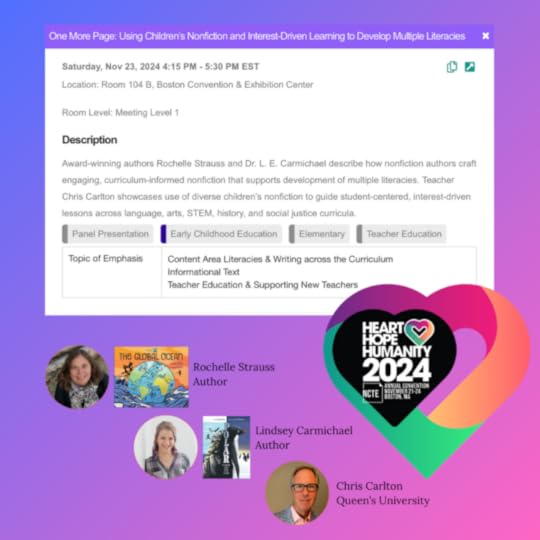
November 1, 2024
Karen Autio: Playing with Friends is Important for ALL Kids
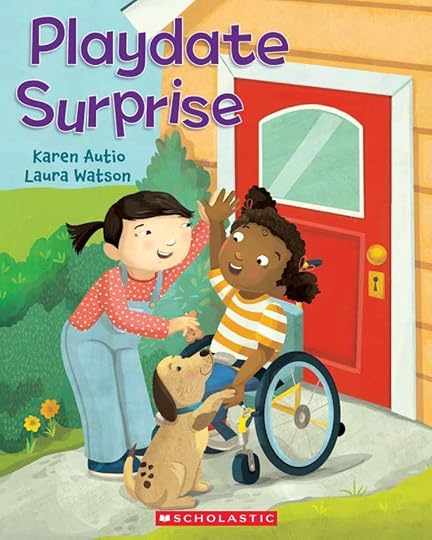 Welcome to Cantastic Authorpalooza, featuring posts by and about great Canadian children’s book creators! Today’s guest:
Karen Autio
. Take it away, Karen!
Welcome to Cantastic Authorpalooza, featuring posts by and about great Canadian children’s book creators! Today’s guest:
Karen Autio
. Take it away, Karen!
The most important tip for having a playdate with a child with developmental disabilities is just to have [a playdate].
—Sarah Lyons, freelance writer and mother of six
Playdates at our home got my super-social daughter, Annaliis, excited. She also loved going to birthday parties, but an even bigger highlight was a playdate at a friend’s home. However, these were rare as she was born with disabilities and used a wheelchair. I understood the hesitance of her friends’ parents in not knowing how to handle accessibility challenges and her disabilities. Still, how I longed for people to simply ask me how they could include Annaliis so she could have more playdate invitations!

Kayla and Piper
Through playdates, children develop the physical, cognitive, creative, social, and emotional skills they need to thrive. They’re a fun way to build resilience and relationships.
As playtime with other children is essential for every child’s well-rounded development, it’s important to make playdates inclusive and accessible!
My newest picture book, PLAYDATE SURPRISE, is a joyful story of friendship, problem-solving, and simple ways to make the world more accessible. When Piper comes over to Kayla’s house for their first playdate, they enjoy all sorts of activities, including dress-up. Annaliis loved getting down on the floor to play dress-up with a friend.
PLAYDATE SURPRISE also shows obstacles to having playdates for children who use mobility devices and how those accessibility challenges can be overcome.
Encourage your child to get to know children who have disabilities. Look for what they have in common. When your child gains a disabled friend and wants to invite them over, don’t hesitate to reach out to the child’s parents who can help you make the playdate amazing.

Annaliis (right) and her friend
Tips for Inviting a Disabled Child for a PlaydateThe key to a safe and fun playdate is preparation. Here are some ways you can ensure both children have a positive experience:
Discuss with the parent of the disabled child the best location for a playdate: your home, their home, or an accessible public place.Ask what their child enjoys and doesn’t enjoy doing so you can plan activities both children will want to engage in.Ask about their child’s accessibility needs, including washroom/restroom access, timing of washroom break, and what assistance is needed.Find out about any allergies and how long of a playdate is appropriate.Invite the parent to the first playdate.Offer a variety of fun, accessible activities.Include some creative or non-competitive options such as building with LEGO, a craft activity, sculpting play dough, or a cooperative game, and provide some solo choices like a reading nook.Beforehand, tell your child who is coming, when, for how long, and what you have planned. Ideas for Making Playdates AccessibleFor the playdate, plan to use the most accessible area(s) of your home. If your house is not wheelchair accessible, set up a play space in the garage, or carport, or outdoors. We often used our carport for playtime, especially for messy activities.
Other options are to meet at an inclusive playground or accessible park, zoo or museum. Watching a movie together at a theatre is another way to connect or having lunch or ice cream at a restaurant. You could enjoy an activity together like skating, bowling, bocce, or a kids’ event at the library.
Keep in mind the main goal of a playdate is to grow the children’s friendship. Have fun!

Accessible Painting
Recommended ResourcesHere are some excerpts from websites full of helpful suggestions, along with links so you can read more:
“Children who are neurodivergent, or who have developmental disabilities, … benefit from playdates as much as their peers. … kids who have disabilities are just like anyone else; they want to interact with friends and be loved and appreciated.”
— Sarah Lyons – Accessible Playdates: What to Keep in Mind for Developmental Disabilities
“… asking about a child’s accessibility needs demonstrates that you care about creating a positive experience … try asking, ‘Is there anything I should keep in mind to make sure this space/activity/event is accessible to [your child]?’”
—The Nora Project: Planning Inclusive Playdates
“Disability is not as different as you might imagine…if you are a parent who wants to help your child invite a friend with a disability over to play, just remember that their friendship, and their shared humanity, can help you understand both of them and help them understand each other.” — Amy Julia Becker: Playdates and Disability
PLAYDATE SURPRISE (Scholastic Canada) and its French translation UNE SURPRISE MERVEILLEUSE (Éditions Scholastic), illustrated by Laura Watson, are ideal for ages 3-8.
Karen Autio, from Kelowna, B.C., is the author of eleven books for children and a sensitivity reader for disability awareness.
October 4, 2024
Alison Lohans: On the Magic of Making Art
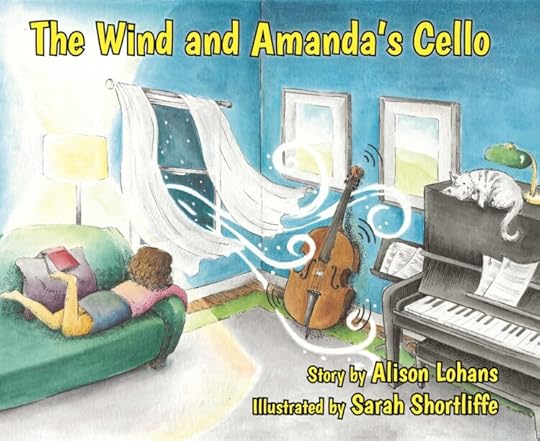 Welcome to Cantastic Authorpalooza, featuring posts by and about great Canadian children’s book creators! Today’s guest:
Alison Lohans
. Take it away, Alison!
Welcome to Cantastic Authorpalooza, featuring posts by and about great Canadian children’s book creators! Today’s guest:
Alison Lohans
. Take it away, Alison!
Creating new things. Sometimes beautiful things.
We rarely know the deep origins, or why a particular “something” begins to wiggle, and then morph into a new creative work. Ever since high school, already writing and very active in music groups, I’ve inherently known that involvement in the arts – whether the written word or music, visual arts, drama or dance – is soul-enriching at the deepest levels. To take this a step further, sitting in band rehearsal one day in the mid-1960s, I was deeply moved by the realization that, playing together as a group, we could create something “truly alive”, something that none of us could attain on our own.
And so it also happens with the development of a picture book. Our manuscript is partnered with just the right artist, and the work comes alive in new ways that neither of us could achieve individually. Then, at the next stage, readers become involved in this same “act of creation” – a three-way transaction in which readers bring their own worlds of experience to what we’ve already created jointly.
My latest experience here is the publication of my newest picture book, The Wind and Amanda’s Cello, illustrated by artist Sarah Shortliffe of Nova Scotia, and released by Shadowpaw Press on September 24 of this year. It’s been amazing working with Sarah (who also happens to play cello!) and writer-publisher Edward Willett/Shadowpaw Press. And it’s been intriguing to see some responses of early reviewers.
The Wind and Amanda’s Cello isn’t the first time I’ve highlighted music in a book for young people. (Others include Nathaniel’s Violin, Foghorn Passage, and Don’t Think Twice.) In this newest book, it was great fun playing with the idea of a mischievous puff of wind swooping into Amanda’s cello as she sat practicing – and then staying there. This magical breath of wind has its own ideas about what Amanda’s music should be. From then on, practicing is less a chore and far more of an adventure. Even people who “don’t like music much” stand there listening as Amanda practices. The music Amanda plays at lessons or concerts isn’t always what’s in the book – but people enjoy it anyway. When Amanda’s baby sister isn’t feeling well, the wind comforts her. Further, when Amanda is invited to play at her little sister’s daycare, “the wind whispered stories that only Amanda and the children could hear”. But… Children have a tendency to grow. And Amanda is eventually told that she’s outgrown her small cello, and needs a bigger one…
To close, I’d like to share John O’Donohue’s “For the Artist at the Start of Day,” from his book To Bless the Space Between Us (Doubleday, 2008, p. 17):
May morning be astir with the harvest of night;
Your mind quickening to the eros of a new question,
Your eyes seduced by some unintended glimpse
That cut right through the surface to a source.
May this be a morning of innocent beginning,
When the gift within you slips clear
Of the sticky web of the personal…
…A morning when you become a pure vessel
For what wants to ascend from silence…
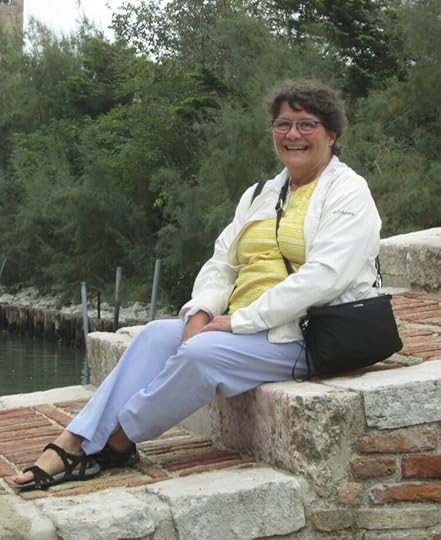 Alison Lohans of Regina, SK is the author of 31 books (primarily for young people) published by Canadian and international presses. She’s won some awards, has taught writing and mentored a number of now-successful writers, served as Writer-in-Residence, given over a thousand readings from her work in schools and libraries across Canada, and does some editing.
Alison Lohans of Regina, SK is the author of 31 books (primarily for young people) published by Canadian and international presses. She’s won some awards, has taught writing and mentored a number of now-successful writers, served as Writer-in-Residence, given over a thousand readings from her work in schools and libraries across Canada, and does some editing.
Since early childhood, Alison has been actively involved in the arts: writing, music, and visual art. She could read simple piano music before she could read words. Growing up in a family where bedtime always meant stories read aloud or retellings of favourite made-up stories; singing; and always a stash of library books on hand – and add a grandmother who occasionally played classical piano after the kids went to bed… How could this unrealized wealth not have an impact? From her earliest years, Alison’s parents included her in “making art” – such as (with her sister) illustrating their dad’s fire engine story, and even illustrating a would-be picture book story that her mother submitted to New York publishers. In high school, Alison reluctantly set aside her passion for visual art because writing and music seemed more important. (Actually, she tried dropping music in order to focus on art, but that didn’t work…) Her university degrees are in Music and Education. In addition to teaching writing, Alison has also taught music at various levels, plays four instruments on a recreational basis (cello, cornet, recorder and piano), and sings in her church choir. Her next picture book “The Best Little Sister in the World” will be released in 2025.
September 28, 2024
Good News for Grey Days
Autumn is creeping up on me. It’s getting dark earlier and there are more cloudy days, neither of which my light-sensitive brain is very happy about. But as things get a little greyer, I’ve been gifted two enormous reasons to celebrate.
Polar has just won the Science Writers and Communicators of Canada Book Award! The SWCC made the announcement at their virtual AGM, which I attended from a hotel room in Alberta, while tethered to my cell phone because the wifi was too weak for Zoom.
Despite the sketchy wifi, it was great fun to talk about science writing with other science writers, and as a huge bonus, I got to meet Polar’s illustrator, Byron Eggenschwiler! For those surprised by this, let me explain: publishing houses usually keep authors and illustrators as far apart as possible, to avoid any clashes of ego or vision. And Byron and I live in different provinces, so while we emailed each other around the time of the book launch, we’d never actually met. He’s great, and I still maintain that you can buy Polar for the illustrations alone and feel like you got your money’s worth. They are that good.
Which brings me to good news part 2: Polar is on the shortlist for the Lane Anderson Award!! I was lucky enough to win the Lane Anderson for Fuzzy Forensics in 2015, and I’m just so thrilled to be nominated again.
I got the news while standing in my sister-in-law’s kitchen, while Tech Support, his nephew, and a dog named Bandit tried to pick the lock on a family trunk that hadn’t been opened in about 65 years. This was them:
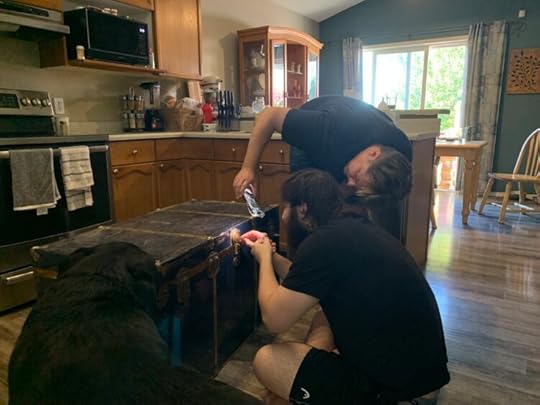
This was me:
Kermit GIF from Kermit GIFsIn case you’re wondering, the trunk contained a quilt, a yearbook from 1959, and an overpowering smell of mothballs – though mysteriously, the mothballs themselves were missing.
And in case you’re eager to read or recommend Polar, it’s available at independent bookstores, and online at:
How is September treating you? Share your good news in the comments!
September 6, 2024
Lana Button: Making Memories with My Grammie’s House
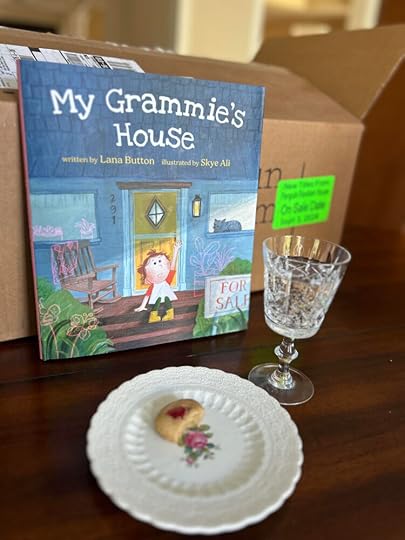 Welcome to Cantastic Authorpalooza, featuring posts by and about great Canadian children’s book creators! Today’s guest:
Lana Button
. Take it away, Lana!
Welcome to Cantastic Authorpalooza, featuring posts by and about great Canadian children’s book creators! Today’s guest:
Lana Button
. Take it away, Lana!
My new picture book is best served with Sprite in a fancy glass and my Grammie’s scotch cake cookies. So set your oven to 325F and mix:
1 pound of soft butter1 ½ cups of packed brown sugar2 egg yolks4 cups of flourMix (best with your hands – like my Grammie used to)Roll into balls, and put a piece of cherry in the middleBake for 20-25 minutes!My Grammie’s House (Tundra) beautifully illustrated by Skye Ali, was inspired by the best kinds of childhood memories- the ones that bring back a sense of comfort and contentment. The child in the story gives a tour to potential home buyers, highlighting the best features of a house for sale. They point out the special nooks and crannies of a well-loved home still alive with memories.
I spent a lot of time in my Grammie Yardley’s house. When I think of her I remember how fun a sliding kitchen floor can be, how beautiful the sound of a slamming screen door can be, how content you can feel watching cookies being rolled into balls.
When I visited Grammie Higgins’s house, she served me Sprite in a fancy glass. My mum would tell her not to fuss, but my Grammie would insist. I remember thinking, ‘My Grammie must think I’m pretty special and important, to be handing me this glass.”
I hope My Grammie’s House fills the reader with a sense of love and contentment. I hope the story inspires the audience to look for the treasures in the nooks and crannies of their world. And I hope it evokes some wonderful memories that can be passed on, like a family recipe.
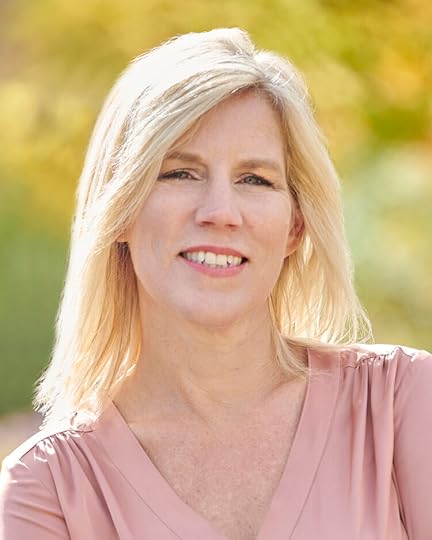 Lana Button is the award-winning author of more than a dozen books for children, which have been translated into 5 different languages, and have received the Crystal Kite Award, the Junior Library Guild Gold Standard Award and the IBBY Outstanding Book for Young Children. Her books have been highlighted in The New York Times and the Wall Street Journal. Lana has presented her stories and positive message on inclusion, empathy and resiliency to thousands of kids at festivals, schools and libraries across North America. Connect with Lana on Instagram @lanabuttonauthor and at www.lanabutton.com.
Lana Button is the award-winning author of more than a dozen books for children, which have been translated into 5 different languages, and have received the Crystal Kite Award, the Junior Library Guild Gold Standard Award and the IBBY Outstanding Book for Young Children. Her books have been highlighted in The New York Times and the Wall Street Journal. Lana has presented her stories and positive message on inclusion, empathy and resiliency to thousands of kids at festivals, schools and libraries across North America. Connect with Lana on Instagram @lanabuttonauthor and at www.lanabutton.com.
August 2, 2024
Heather Stemp: How My Family’s Link to Amelia Earhart Became a Series
Welcome to Cantastic Authorpalooza, featuring posts by and about great Canadian children’s book creators! Today’s guest: Heather Stemp . Take it away, Heather!
I began writing Amelia & Me, the first book in the Ginny Ross Series, when Amelia Earhart dropped into my family history. The convergence of Amelia’s history with my own was an opportunity I couldn’t ignore. It was 1932, and my aunt, Ginny Ross, met Amelia when she arrived in Harbour Grace Newfoundland to depart on her solo transatlantic flight. The book describes how Amelia convinces my aunt, and so many other young women, that anything is possible if they refuse to give up.

The second book, Under Amelia’s Wing, is set in 1936 at Purdue University. Amelia is hired as a part-time career counsellor for women and an aviation advisor. This is a logical next step for Ginny who longs to follow in Amelia’s footsteps. In spite of everything she has accomplished, even Amelia Earhart has critics who think women belong in the kitchen, not in the cockpit. But both Amelia and Ginny refuse to give up until Amelia disappears in 1937 during her round-the-world flight. Ginny is then faced with the additional challenge of trying to carry on without her mentor and friend.
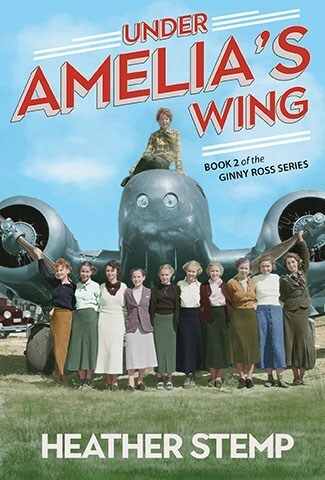
The third and final book in the series, Beyond Amelia, explores Amelia’s legacy. It’s 1940, war is raging in Europe, and Ginny Ross longs to join the fight against Hitler. She’s a capable pilot, thanks to mentoring from Amelia Earhart and her training at Purdue University, but she’s not allowed to use her skills in the US Army Air Corps, which only allows men to fly.
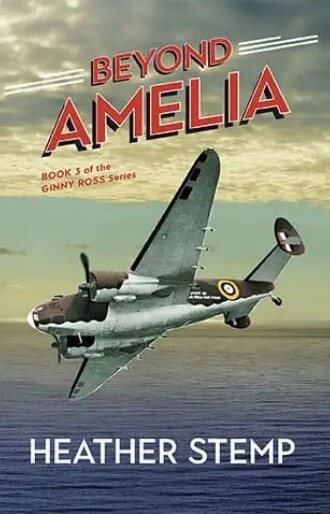
When a new service is created to secretly fly bombers from Newfoundland to the UK to join in the fight, Ginny realizes how she can help. She cuts her hair, changes her name, and heads to Canada as Jimmy Ross. In her disguise, Ginny takes part in the risky and vitally important mission to bring more air power to the allied forces.
Although she is determined to face down any danger, from engine failure to Blitz bombing, Ginny never anticipates that another danger lurks much closer…in the secret she’s keeping from the men around her.
Based on the true history of the heroic Ferry Command, Beyond Amelia is a story about the sacrifices so many young people made to turn the tide in a terrifying war.
Like others who write historical fiction, I love the research that takes me to places I’ve never imagined going. In writing this series, I learned so much more about my own history as I explored Amelia’s. Writing historical fiction for young people is an important opportunity. By opening new worlds to our readers, perhaps we can help them to develop new ways of thinking.
Thanks, Lindsey, for this amazing opportunity to share my story. The Ginny Ross Series, Nimbus Publishing and Vagrant Press, is available now.
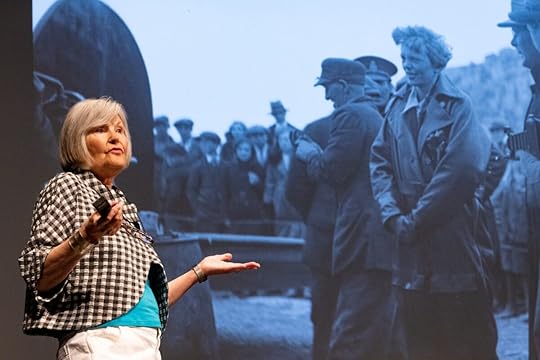
July 16, 2024
News Updates and Summer Traditions
So apparently it’s the middle of July already? The backyard menagerie doesn’t seem surprised by this news. The first clutch of robins has fledged, and a pair of goldfinches have set up house in a tree just over the neighbour’s fence, so we get to watch them swoop past our deck on their supply runs.
And several baby DoGs have joined the original Destroyer of Gardens, who has learned a new trick:
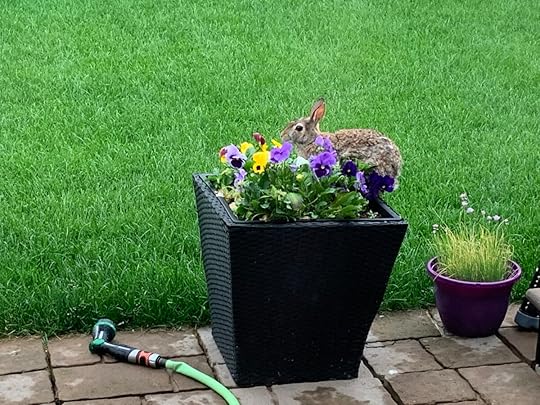
That’s right: it’s chewing the pansies while SITTING ON the pansies. I’m still not sure how it got up into the planter….
The hot weather seems to make people interested in cool reading: Polar has picked up three more award nominations!
Skipping Stones Honor Awards – Nature and Ecology Books
Red Cedar Children’s Choice Book Awards – Nonfiction
Science Writers and Communicators of Canada – Children’s Shortlist
There are a ton of books on these lists I haven’t had a chance to read yet, but I can vouch for Heather Camlot’s Becoming Bionic – it’s fantastic. And Heather is an excellent human being, so definitely check out her work when you can.
Watching summer zoom by (again) has Tech Support and I frantically attempting to schedule essential summer fun activities. Spontaneity does NOT work for us – if it’s not in the calendar, it doesn’t happen.
One of the things we make a point of doing every year is going to a movie at the local drive-in theatre. It’s COVID-safe (because the virus is NOT gone, despite what many people seem to think) and – even though we are now of an age where we have to plan a nap the day of the movie and a nap the day after in order to stay up so long past our usual bedtime – it’s a lot of fun. Part of the fun is that we always choose “traditional” drive-in fare, which usually means terrible monster movies, and it’s nice to be able to make fun of them in the privacy of our own car. Last year, we saw The Meg 2, which did not contain nearly enough sharks, and I spent most of the film scarfing popcorn and chanting “Bitey, bitey, bitey” while far too few people actually got bitten. This year, we’re thinking Twisters. All I remember of the original Twister is the flying cow, which bodes pretty well for ridiculousness in the sequel.
What about you? What summer traditions are you enjoying these days?
July 5, 2024
Sheryl McFarlane: Introducing The Blue Canoe
Welcome to Cantastic Authorpalooza, featuring posts by and about great Canadian children’s book creators! Today’s guest: Sheryl McFarlane . Take it away, Sheryl!
Hi, I’m Sheryl McFarlane and I’m so excited to share my new picture book, The Blue Canoe. It’s published by Familius and beautifully illustrated by Laurel Aylesworth.
Every cabin day is a paddle-on-the-lake day.
You’ll be paddling with us too, coming-soon baby.
Mom and me and you in our blue canoe.
A mother and daughter love to canoe on the little lake at their family cabin.
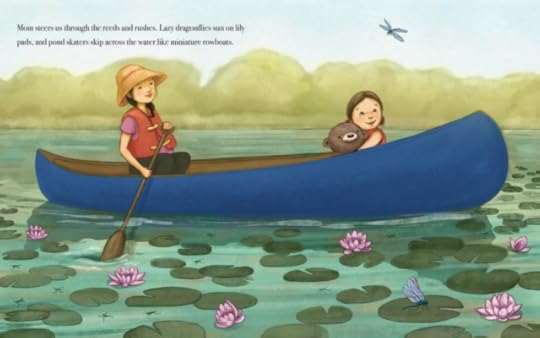
With her mother expecting a new baby, their paddling time together provides a perfect opportunity to explore local flora and fauna and for the girl to imagine being a big sister…playing in the water like the otter family they pass, and teaching her new sibling boat words like a rope is called a painter.
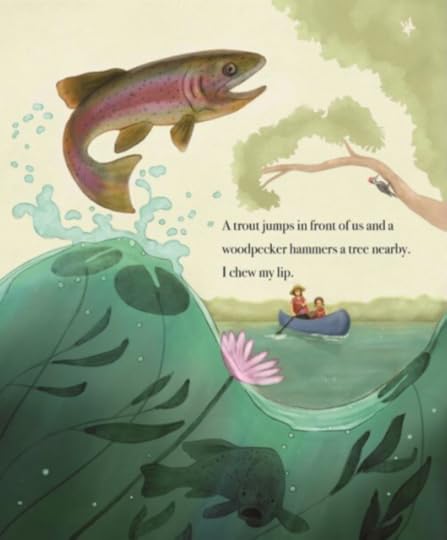
Still, she worries about the changes a new baby will bring…
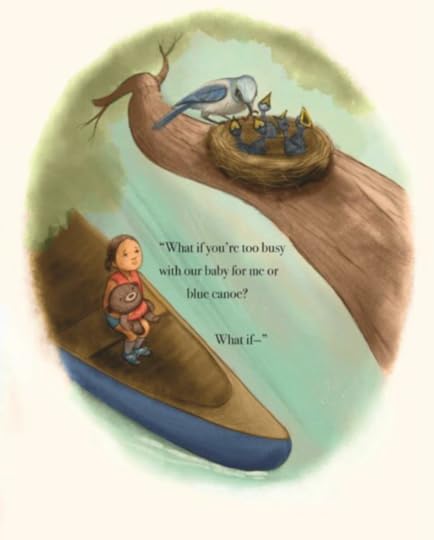
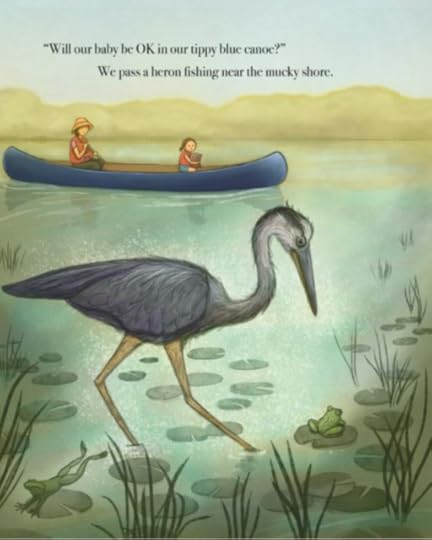
Mom doesn’t dismiss her daughter’s worries but gives honest and reassuring answers like…Yes, I’ll be busy sometimes, but we will continue to paddle on the lake together.
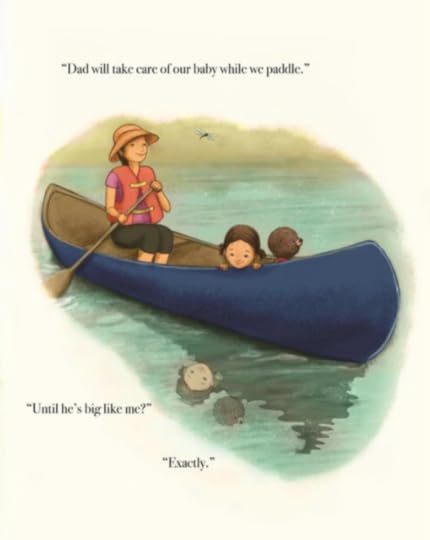
The Blue Canoe is a poignant picture book conversation that addresses big feelings.
It’s perfect for growing families who value the beauty of nature.
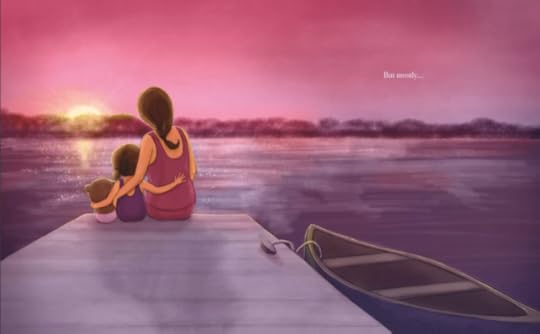
When my children were young, we had a lakeside cabin. My husband and I loved the outdoors and loved sharing nature with our young children. Ours was a battered, grey canoe held together with duct tape and badly in need of repairs. It was not as pretty as the one Laurel painted, but we had marvellous lake adventures paddling together. The flora and fauna pictured here are only a sample of what you might discover if your family takes up canoeing. Happy paddling!
 Canoe WordsAft: Toward the rear, or stern, of the canoe.Bail: To empty water from a craft by scooping it out with anything from a sponge to a tin can.Belly: The bottom of the canoe.Bow: The front or extreme forward end of the canoe.Gunnel: The section along the top of the canoe from stern to bow where the sides meet; a strip along the top of the canoe’s sides.Paddle: The instrument used to propel a canoe through the water.Painter: A rope attached to the bow or stern of the canoe, used for tying, towing, or lining the canoe. A painter can also be used as a safety line in case of a capsize or a rescue.Port: The left side of the canoe when facing the bow.PFD: Personal Flotation Device. Always wear a PFD when canoeing.Starboard: The right side of the canoe when facing the bow.Stern: The rear of the canoe. Classroom Activities
Canoe WordsAft: Toward the rear, or stern, of the canoe.Bail: To empty water from a craft by scooping it out with anything from a sponge to a tin can.Belly: The bottom of the canoe.Bow: The front or extreme forward end of the canoe.Gunnel: The section along the top of the canoe from stern to bow where the sides meet; a strip along the top of the canoe’s sides.Paddle: The instrument used to propel a canoe through the water.Painter: A rope attached to the bow or stern of the canoe, used for tying, towing, or lining the canoe. A painter can also be used as a safety line in case of a capsize or a rescue.Port: The left side of the canoe when facing the bow.PFD: Personal Flotation Device. Always wear a PFD when canoeing.Starboard: The right side of the canoe when facing the bow.Stern: The rear of the canoe. Classroom ActivitiesAs a former teacher, I loved using picture books to introduce a theme or concept. Here are some fun ways for primary and preschool teachers to extend the learning.
Create a list of all the birds found in The Blue Canoe. Use a birding guide to help identify each species of bird. How does that compare with local birds?Create a list of the animals found in The Blue Canoe. Put them into categories; for example, insects, birds, amphibians, mammals. Are local animals different or similar?Create a food web based on the plants and animals in the book.Older kids may enjoy creating an origami canoe. Use a rectangular sheet of paper paper to create an easy origami canoe. Discuss the feelings the little girl has about a new baby and the ways that talking about feelings can be helpful.The Blue Canoe is available through your favourite Indie bookstore, via Amazon, Chapters/Indigo, Barnes and Noble, and Target.
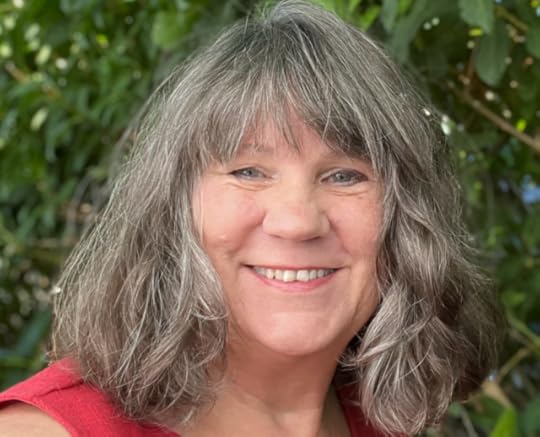 Sheryl is the author of eighteen books for kids. She lives in Victoria, BC where she enjoys gardening, beach walks with her little dog, Karl, gardening and stocking her little free library. Visit her at www.sherylmcfarlane.ca
Sheryl is the author of eighteen books for kids. She lives in Victoria, BC where she enjoys gardening, beach walks with her little dog, Karl, gardening and stocking her little free library. Visit her at www.sherylmcfarlane.ca
June 24, 2024
Sharing STEM at Science Rendezvous
Apparently Science Rendezvous Kingston was SIX WEEKS ago, and I haven’t posted about it yet?! In my defence, COVID took up two of those weeks. I’d managed to avoid catching it up to this point, but after getting up close and personal with literally thousands of children during Book Week and Science Rendezvous, it was less a question of whether I’d get sick and more a question of with what.
And speaking of COVID, if you’ve still got any of those green-box tests kicking around your house, throw them away. The company that made them falsified their data, and it turns out they’ve never really worked properly. That’s even more true now, when the virus has mutated to the point that rapid tests have a much harder time detecting it. I, for example, tested negative the entire time I was sick… but I knew it was COVID because I had the same skin sensitivity I experienced after every vaccination. No other virus has ever caused that feeling of all-over sunburn! Or a week of total exhaustion, even after the symptoms had cleared…
But back to Science Rendezvous!
I attended with author-friends Rochelle Strauss, Elaine Kachala, and Ishta Mercurio. Here’s a picture of most of us at our lovely, tidy booth before the event began:

From left to right: Elaine Kachala, Rochelle Strauss, L. E. Carmichael, eagerly awaiting an audience!
And here’s what it looked like when the hordes had descended!
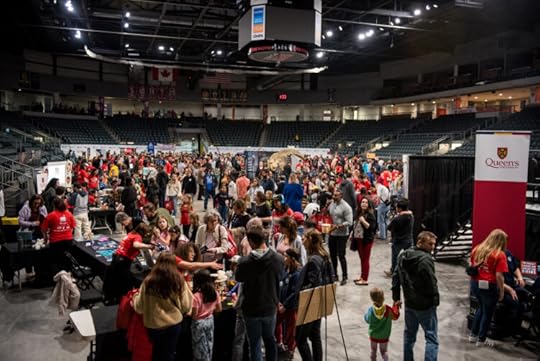
The final count for the day was over 5200 people. The energy in the room was incredible – as was the noise! By the end of the day, my throat was sore from shouting and my ears were ringing like they do after a rock concert… though that might have been because we were right next to the stage, where the Queen’s Chemistry department was gleefully blowing things up!
I swear that most of those 5200 people passed by my booth at one point. I brought one of my favourite props – an arctic fox skull from one of the animals I studied during my PhD:
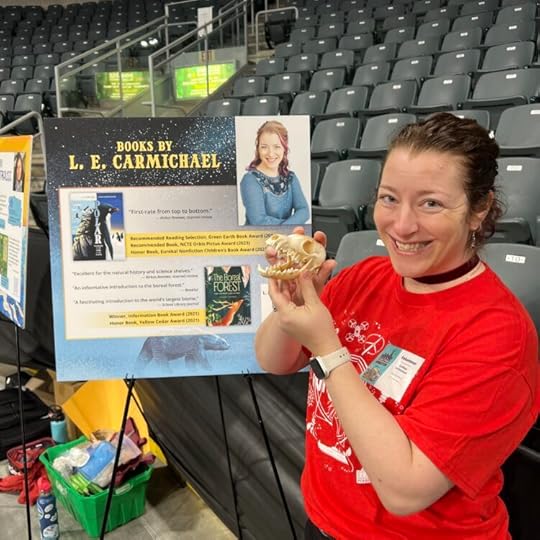
A lot of the younger kids took one look and yelled “dinosaur!” because the only bones they’ve ever seen are fossils. It blew their minds to learn that the skull was from a fox – and that humans have skulls, too! They also loved getting to touch the tuft of fox fur I brought to show them how Polar animals keep warm.
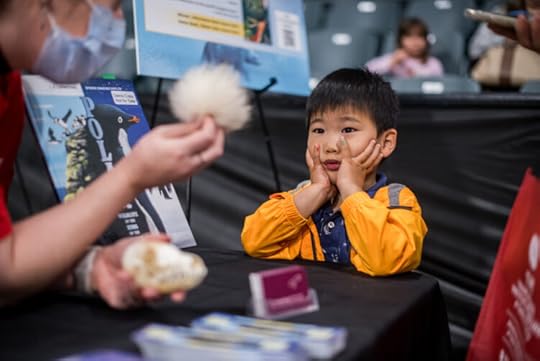
The adults, on the other hand, were fascinated by the peat moss water filter I’d rigged up – a small-scale demonstration of how peat bogs in the boreal forest clean our water for us. Check out the gatorade bottles in the centre of the display:
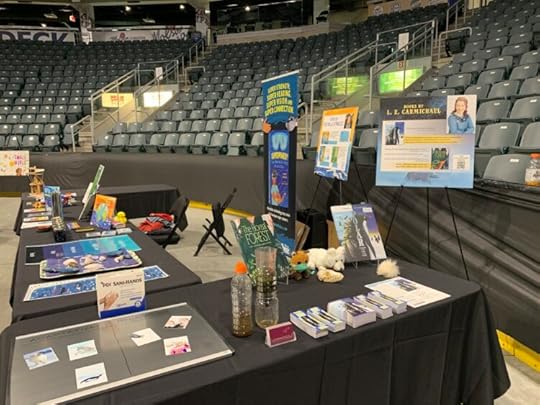
It was a noisy, overwhelming, whirlwind of a day. But watching that many eyes go wide with the light of scientific discovery? Totally worth the exhaustion… and the COVID.

Ishta Mercurio demonstrates Leonardo da Vinci’s flying machine!
June 8, 2024
Rochelle Strauss – Building Ocean Literacy on World Ocean Day
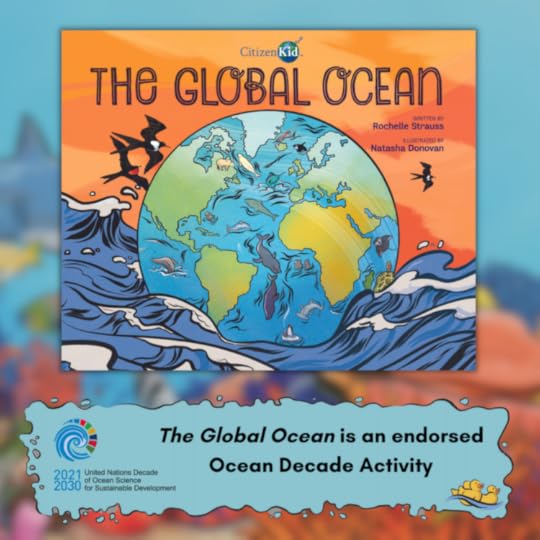 Welcome to Cantastic Authorpalooza, featuring posts by and about great Canadian children’s book creators! Today’s guest:
Rochelle Strauss
. Take it away, Rochelle!
Welcome to Cantastic Authorpalooza, featuring posts by and about great Canadian children’s book creators! Today’s guest:
Rochelle Strauss
. Take it away, Rochelle!
Take a deep breath in.
Now hold it.
You probably know that you have the trees to thank for that breath you just took. Trees and other plants provide the oxygen that makes Earth habitable. But they don’t work alone! The ocean also provides oxygen to the planet.
In fact, if forests are considered the lungs of the earth; then the ocean may very well be Earth’s heart.
(Ok, you can let that breath out now, if you haven’t already…  )
)
Not only does the ocean (yes, THE ocean, there is only one) provide oxygen, but it also shapes the planet’s weather and climate too. Its currents circulate water around the planet, moving warm and cold water, as well as nutrients and oxygen. It stores carbon dioxide from the atmosphere, and is a source of food for many species, including us. All life on Earth started in the ocean. And today, the ocean is home to more biodiversity (the diversity of species) than anywhere else on the planet. It’s also home to the greatest number of organisms on the planet, and more different habitats than on land.
Much like your heart keeps you alive and healthy, the ocean is what keeps the planet flourishing and sustains all life on Earth. It may be Earth’s most important feature.
But the ocean is in trouble. No matter where we live, our activities are having a huge impact on the health of the global ocean. Climate change, pollution and plastics, habitat loss and overfishing are putting stress on the ocean.
Keeping the ocean healthy is paramount and to do that, we all need to build our Ocean Literacy. Ocean literacy is our understanding of the impact the ocean has on us, and that we are having on the ocean. Building our ocean literacy is the key to becoming stewards of the ocean and protecting Earth’s beating heart.
That’s why every year, on June 8th, we celebrate World Ocean Day. It’s also why the UN has devoted an entire decade to building our Ocean Literacy.
The United Nations Decade for Ocean Science for Sustainable Development (2021-2030) – or simply, The Ocean Decade – is dedicated to helping us build the science we need for the ocean we want. Hundreds of ocean activities, led by UN entities, researchers, governments, NGOs, educators, community groups and many others, are expected to take place around the world, moving the Decade’s mission forward. And I am honoured that my latest book, The Global Ocean (Kids Can Press, 2022), has officially been recognized as a UNESCO endorsed Ocean Decade Activity.
We need the global ocean to be healthy so that it can continue to support every living species on Earth, including us. Thankfully, people around the world are taking charge and leading the way to conserve and restore the global ocean. And these ripples of change are leading to the bigger waves of change needed to protect the ocean.
What ripples of change will you add?
Learn MoreThe first step to building YOUR ocean literacy, is, of course, to learn more about the ocean. As an author, I always encourage starting with a good book! But here are some other great resources to help you learn more and take action:
World Ocean Day – lots of learning, resources and a global ocean day events listingOcean Week Canada – a database of Canadian Ocean Week eventsCanadian Ocean Literacy Coalition Ocean Network Canada All-Atlantic Blue Schools – if you are a teacher, consider becoming part of the All-Atlantic Blue Schools Network. There are specific chapters for Canada and the US too. If you are based outside North American, check out the Network of European Blue Schools. National Marine Educators AssociationSpecial thanks to Lindsey for sharing space on your blog to celebrate World Ocean Day. Lindsey – you’ve now officially created a ripple of change AND participated in an Ocean Decade Activity!
About Rochelle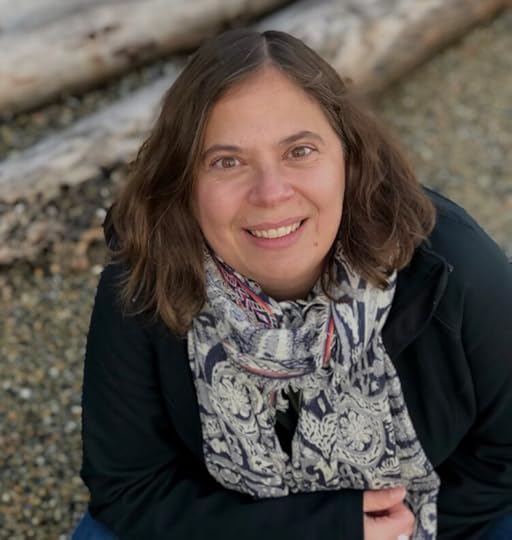
Rochelle Strauss wants to change the world – one book at a time. An environmental educator and children’s author based in Toronto, Canada, Rochelle is passionate about using children’s non-fiction books as tools for building environmental literacy. Her best-selling titles include The Global Ocean, One Well: The Story of Water on Earth, and Tree of Life: The Incredible Biodiversity of Life on Earth. You can follow Rochelle’s journey through Instagram @rochellestraussauthor



